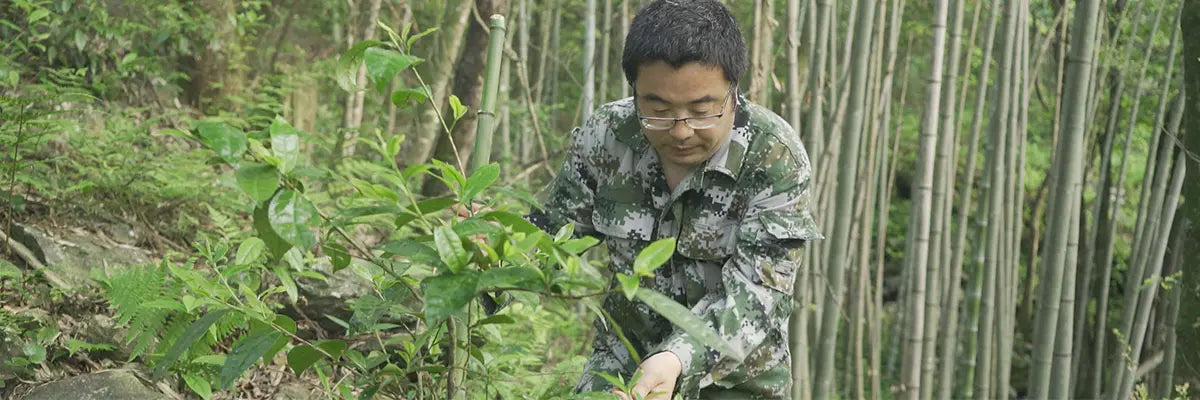Have you ever brewed a cup of oolong tea that looks and tastes just like green tea?
You might wonder if you got the wrong tea—or worse, if it’s a fake. But in many cases, it’s not a mistake. What you have could be a lightly oxidized Oolong.
Take our two teas, Biluochun and Tie Guan Yin, for example. At first glance, they look strikingly similar—both feature tightly rolled leaves and a vibrant green infusion. But don’t be fooled by appearances. So, how do you tell them apart?

Biluochun oolong tea Liquor color and aroma

Tie Guan Yin oolong tea Liquor color and aroma
What’s the Difference Between Lightly Oxidized Oolong Tea and Green Tea Processing?
1. Green Tea--Non-oxidized Teas
It skips oxidation entirely. The leaves are quickly heated to lock in freshness, giving them a bright, vegetal flavor. For example, Longjing (Dragon Well) and Biluochun are popular green teas with light, grassy profiles.
2. Lightly Oxidized Oolong Tea--Partially oxidized teas
Lightly Oxidized Oolong Tea is lightly oxidized (about 10%–20%) and processed through gentle rolling and shaking to bring out subtle floral or fruity notes. Tie Guan Yin (Iron Goddess) in its fresh, floral style and Sijichun (Four Seasons Spring) are classic examples.

High temperature rapid fixation of fresh green tea leaves

Oolong tea tumbling: Bruise leaf edges mechanically or manually to create red edges ("green leaves with red borders").
How to Distinguish Lightly Oxidized Oolong Tea from Green Tea by Aroma and Flavor?
1. Green Tea
Appearance: Bright green leaves, often flat or curled, depending on the variety.
Aroma: Fresh, grassy, and sometimes a bit nutty.
Taste: Crisp and refreshing, with a light sweetness and sometimes a touch of bitterness.
2. Lightly Oxidized Oolong Tea
Appearance: Leaves are tightly rolled or twisted, with hues of green and yellow.
Aroma: Floral and fruity, like orchids or honey, with a hint of complexity.
Taste: Smooth and layered, combining delicate floral or fruity flavors with a silky texture.
How to Brew Oolong Tea and Green Tea?
1. Green Tea
Water Temperature: Cooler (around 160°F–185°F) to preserve its delicate flavors.
Steeping: Quick brews, usually 2–3 infusions.
2. Lightly Oxidized Oolong Tea
Water Temperature: Slightly hotter (around 185°F–200°F) to release its complex aroma and taste.
Steeping: Great for multiple infusions—flavors evolve with each steep.

How Should We Choose?
1. Green Tea
Ideal for those who want a lighter, low-caffeine option that’s perfect for hydration or a gentle pick-me-up.
Best for: Fans of fresh, straightforward teas that pair well with light meals.
2. Lightly Oxidized Oolong Tea
Perfect for someone who enjoys exploring nuanced, multi-layered flavors. It’s great for savoring and unwinding after a busy day.
Best for: Tea enthusiasts ready to step up their tea game with something a little more sophisticated.
Tea Recommendations for Beginners
1. Green Tea Recommendations
- Longjing (Dragon Well)
Flavor Profile: A classic with nutty and bean-like aromas, and a sweet, refreshing taste.
Best for: Those who enjoy traditional Chinese green tea flavors.
- Biluochun
Flavor Profile: Rich in fruity and floral aromas, with a fresh, crisp taste and a clear, layered profile.
Best for: Those who like a sweet, delicate tea with a smooth, light flavor.
- Xinyang Maojian
Flavor Profile: This tea from Henan province has long, thin leaves and a fresh, green aroma. The taste is mellow and smooth with a subtle floral and bean-like note.
Best for: Tea lovers who appreciate a clean, fresh taste with a noticeable aftertaste.
- Liu'an Guapian
Flavor Profile: Known for its large, thick leaves, this tea from Anhui offers a fresh, bean-like aroma with a hint of grassiness. The taste is light with a slight bitterness.
Best for: Those who enjoy a light, fresh tea with a bit of bitterness.
- Huangshan Maofeng
Flavor Profile: A bright and fresh tea from Anhui, offering a subtle chestnut aroma and a smooth, sweet taste with a long-lasting finish.
Best for: Those who enjoy a clean, sweet taste with a delicate aroma.
- Enshi Yulu
Flavor Profile: This tea from Hubei is grown in shaded conditions, preserving a sweet, delicate flavor with a hint of seaweed aroma.
Best for: Tea drinkers who love a sweet, fresh taste with a unique twist, especially fans of Japanese-style teas.
- Taiping Houkui
Flavor Profile: Known for its large, long leaves, this tea has a light floral aroma and a sweet, smooth taste.
Best for: Those who want to try something with an interesting appearance and a fresh, delicate fragrance.
2. Lightly Oxidized Oolong Tea Recommendations
- Tie Guan Yin
Flavor Profile: Fresh floral aromas, especially orchid, with a sweet aftertaste.
Best for: Those who love floral teas but don't want something too heavily roasted.
- Sijichun
Flavor Profile: Honey-like sweetness with a smooth, velvety mouthfeel, perfect for beginners.
Best for: Those looking to try lightly oxidized oolong for the first time.
- Wenshan Baozhong
Flavor Profile: Very lightly oxidized (around 10%), with a strong floral fragrance and a delicate, smooth taste.
Best for: Those who prefer subtle flavors and appreciate a strong aromatic tea.
- Huangjin Gui
Flavor Profile: Unique osmanthus-like floral fragrance with a refreshing, light taste and a quick aftertaste.
Best for: Those seeking something different from traditional oolong tea with a sweet floral aroma.
- Alishan Light Roast Oolong
Flavor Profile: From Taiwan’s high mountains, this tea has a smooth, creamy texture with floral and milky notes.
Best for: Those wanting to experience the smooth, delicate taste of Taiwanese oolong.

If you’re after something clean and refreshing, green tea is the way to go. But if you want a tea that tells a story with every sip, lightly oxidized oolong tea is an adventure worth exploring. Why not try both and discover your favorite? After all, every cup is a chance to savor something special!




















